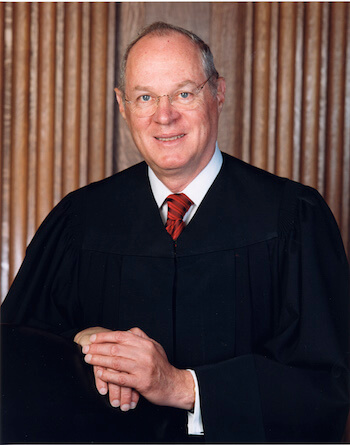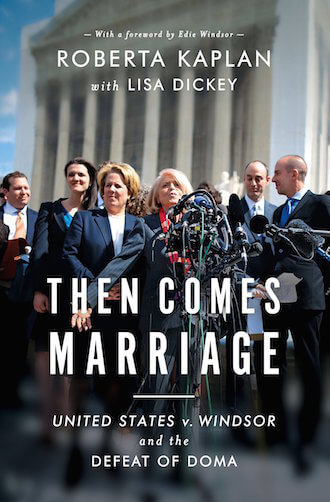State Senator Jim Dabakis, Utah's Democratic Party chair, and partner Stephen Justesen, were among 35 couples married by Salt Lake City Mayor Ralph Baker in December. | TWITTER.COM
BY ARTHUR S. LEONARD | In a burst of pro-gay rulemaking, federal appeals and trial courts on June 24 and 25 issued important pro-gay decisions, advancing not only the cause of marriage equality but also the broader fight for constitutional anti-discrimination protections.
In a ruling reported in this issue, the Ninth Circuit Court of Appeals refused to reconsider its January decision that established heightened scrutiny — under which a law under challenge is presumed unconstitutional unless the government can demonstrate a compelling rationale for it — as the appropriate standard of judicial review in gay rights cases.
The following day, a three-judge panel of the 10th Circuit ruled that Utah’s ban on same-sex marriage unconstitutionally deprives couples of a fundamental right. Also on June 25, a federal district judge in Indiana ruled similarly in a challenge to that state’s ban on same-sex marriage.
Three federal courts issue important pro-gay decisions, with 10th Circuit upholding Utah win
Unlike the 10th Circuit, which stayed its ruling pending the state’s anticipated further appeal — to either the full 10th Circuit or the Supreme Court — Judge Richard L. Young in Indianapolis specified that his ruling would have immediate effect. The state is likely to seek a stay from the Seventh Circuit Court of Appeals in Chicago.
The 10th Circuit ruling — the first by a federal court of appeals to rule that bans on same-sex marriage unconstitutionally deprive same-sex couples of a fundamental right — is the most significant of the three in its impact on the marriage movement. The court’s opinion, by Judge Carlos F. Lucero, appointed to the bench by Bill Clinton in 1995, held the State of Utah to the burden of showing its marriage ban was narrowly tailored to accomplish a compelling state interest.
The state argued that the plaintiffs were seeking a new constitutional right of “same-sex marriage,” but the court decisively rejected that assertion. The Supreme Court’s prior rulings identifying marriage as a fundamental right all involved different-sex couples, but the court found that distinction irrelevant, Lucero agreeing “with plaintiffs that in describing the liberty interest at stake, it is impermissible to focus on the identity or class-membership of the individual exercising the right.”
He quoted New York’s former chief judge, Judith Kaye, from her dissent in the 2006 case where marriage equality advocates here lost, in which she wrote, “Simply put, fundamental rights are fundamental rights. They are not defined in terms of who is entitled to exercise them.” Lucero continued, “Plaintiffs seek to enter into legally recognized marriages, with all the concomitant rights and responsibilities enshrined in Utah law. They desire not to redefine the institution but to participate in it.”
The 10th Circuit found support for this conclusion in both the Supreme Court’s 2003 Texas sodomy ruling and its decision last year striking down the Defense of Marriage Act — both of which stressed that the right to marry is about an individual’s right of choice.
“As the district court eloquently explained, ‘it is not the Constitution that has changed, but the knowledge of what it means to be gay or lesbian,’” Lucero wrote. “Consistent with our constitutional tradition of recognizing the liberty of those previously excluded, we conclude that plaintiffs possess a fundamental right to marry and to have their marriages recognized.”
The court found that none of the state’s justifications for its marriage ban survived its demanding strict scrutiny review. Lucero efficiently eviscerated Utah’s arguments regarding procreation, child-rearing, tradition, social convention, religious liberty, and the democratic decision-making that led to the state’s constitutional ban on gay marriage. His opinion drew on the blizzard of district court rulings since the Utah ban was first struck down in December that have thrown out similar bans in state after state. Nothing Utah’s lawyers came up with had not been repudiated in one of those rulings.
The court’s majority also rejected Utah’s argument that the Supreme Court’s decision not to hear a gay marriage case back in 1972 — for lack of a “substantial federal question” — was still binding on lower courts. Subsequent high court rulings since then superseded that precedent, the court found.
Judge Paul Joseph Kelly, appointed to the court by George H. W. Bush in 1992, sharply disagreed about the 1972 precedent and about the conclusion that the Utah case involves a fundamental right. In his view, Utah’s concerns about the potential dangers of “redefining” marriage sufficed to uphold its ban.
Since the 10th Circuit majority viewed the case as one involving a fundamental right — which meant the marriage ban was subject to strict scrutiny — it ducked a question that played a central role in many other marriage equality cases: whether the plaintiffs’ claims of sexual orientation discrimination required heightened scrutiny of the state’s marriage policy. As reported in this issue, heightened scrutiny is now the standard that the Ninth Circuit will bring to the pending marriage cases there — an approach that will undoubtedly lead to a string of additional victories by same-sex couple plaintiffs.
Acknowledging that the Supreme Court had issued a stay of the original district court order in the Utah case, Lucero wrote that the circuit court would also stay its ruling. If the state does not seek review in the Supreme Court, however, the 10th Circuit will lift its stay. Otherwise, the stay will remain in effect until the Supreme Court either declines to hear the case or affirms the 10th Circuit’s ruling.
Judge Young’s ruling in the Indiana case might be overshadowed by the 10th Circuit decision, but in the short run might appear the more consequential because Young did not stay his ruling. There had been little doubt how he would rule since, in April, he ordered the state to recognize the same-sex marriage of one of the plaintiff couples, Nikole Quasney and Amy Sandler, because Quasney is suffering from ovarian cancer that is no longer treatable. His opinion at that time made clear his view that the state was unlikely to succeed in its defense of its marriage ban.
So the only real suspense in Indiana was about when the decision would be issued and whether it would be stayed pending appeal. The Seventh Circuit, where the state’s appeal would go, is already considering an appeal of the recent Wisconsin marriage equality ruling.
Like the 10th Circuit, Young treated this as a fundamental rights case, applied strict scrutiny to the Indiana ban, and concluded the state failed to meet its heavy burden of showing the policy was necessary to achieve a compelling state interest. He found that the ban was not “closely tailored” to Indiana’s goal of “encouraging [a different-sex] couple to stay together for the sake of any unintended children their sexual union may create.” Gays and lesbians are excluded from marriage, Young noted, but “post-menopausal women, infertile couples, or couples that do not wish to have children” are not.
Even had Young not viewed the case as one involving a fundamental right, he would have struck down the gay marriage ban. From an equal protection perspective, he found, “The court finds that there is no rational basis to exclude same-sex couples.”
Even accepting the state’s contention that marriage laws should be geared to the interests of a couple’s children did not suffice in upholding the ban, with Young pointing out, “The purpose of marriage — to keep the couple together for the sake of their children — is served by marriage regardless of the sexes of the spouses.”
Writing that he had “never witnessed a phenomenon throughout the federal court system as is presented with this issue,” Young concluded, “In less than a year, every federal district court to consider the issue has reached the same conclusion in thoughtful and thorough opinions — laws prohibiting the celebration and recognition of same-sex marriages are unconstitutional. It is clear that the fundamental right to marry shall not be deprived to some individuals based solely on the person they choose to love. In time, Americans will look at the marriage of couples such as Plaintiffs, and refer to it simply as a marriage — not a same-sex marriage.”



































